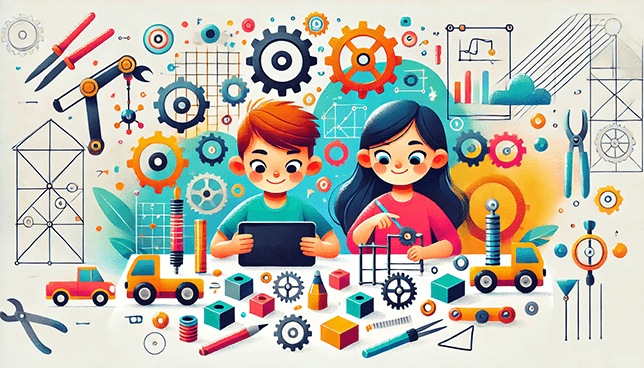NEP and Its Impact on STEM Education in Indian CBSE Schools
The National Education Policy (NEP) of 2020 is a monumental shift in the Indian education system, aimed at making it holistic, student-centric, and future-ready. One of its most transformative effects can be seen in STEM education in India, particularly within CBSE schools. By focusing on experiential learning, interdisciplinary approaches, and equitable access, the NEP is laying the groundwork for an innovative future where Indian students are equipped with 21st-century skills.
This article explores the impact of NEP on STEM education in CBSE schools, addressing key changes, challenges, and opportunities. Whether you’re an educator, a student, or a parent, this analysis will provide a comprehensive understanding of how NEP is shaping the future of learning.
The Vision of the National Education Policy
The National Education Policy is a visionary roadmap aimed at transforming India into a global knowledge hub. It seeks to bridge gaps in the education system by shifting focus from rote memorization to skill development and application-based learning. NEP emphasizes the integration of emerging technologies, creativity, and problem-solving into the curriculum—an approach that is particularly evident in its treatment of STEM education.
NEP’s primary objective is to foster critical thinking, innovation, and collaboration among students, ensuring they are employable and capable of driving change in the world. CBSE schools, which follow a standardized curriculum, are at the forefront of implementing these reforms.
What Is STEM Education in India?
STEM education, an acronym for Science, Technology, Engineering, and Mathematics, focuses on developing problem-solving skills, creativity, and analytical thinking. In India, STEM education is no longer confined to traditional classroom learning. Under NEP, it is evolving into a dynamic, application-oriented framework that equips students with the tools to excel in fields like robotics, artificial intelligence (AI), biotechnology, and more.
With NEP’s emphasis, STEM education in CBSE schools is transforming from a theory-heavy curriculum into an engaging and practical experience. This ensures that students not only understand scientific concepts but also know how to apply them in real-world contexts.
Key Highlights of NEP’s Impact on STEM Education
Experiential Learning as the Core
Under NEP, CBSE schools are focusing on hands-on activities and real-world applications of scientific principles. Experiments, projects, and innovation challenges are replacing rote-based learning. For example, students are now encouraged to use labs to test theories rather than simply memorizing formulas from textbooks.
Introduction of Coding and Computational Thinking
To prepare students for the digital age, NEP mandates the introduction of coding from Grade 6. CBSE schools now include modules on programming languages, algorithms, and computational logic, ensuring early exposure to technology. This step not only sparks creativity but also equips students with essential skills for future tech-driven careers.
Interdisciplinary and Inquiry-Based Approach
NEP promotes blending STEM with arts and humanities, giving rise to STEAM education. This approach fosters creativity while developing critical thinking. For instance, students might combine engineering and art to design sustainable architecture models.
Focus on Problem-Solving and Innovation
Project-based learning (PBL) is a core element of NEP’s STEM framework. By working on real-life challenges, such as renewable energy solutions or water conservation projects, students enhance their problem-solving abilities and learn to think critically.
Inclusion and Equity in STEM Education
NEP emphasizes inclusivity by encouraging marginalized communities and female students to participate in STEM fields. Scholarships, mentorship programs, and awareness campaigns are bridging gender and social divides in CBSE schools.
Teacher Empowerment: A Pillar of NEP’s STEM Vision
A significant aspect of NEP is teacher training. Without well-trained educators, even the most innovative policies cannot succeed. To enhance STEM education in CBSE schools, NEP prioritizes:
Continuous Professional Development (CPD): Teachers undergo regular workshops and training sessions to stay updated with the latest methodologies and technologies.
Collaborative Learning: Teachers are encouraged to collaborate with industry professionals and academic experts to bring real-world insights into classrooms.
Pedagogical Innovations: Blended learning models, flipped classrooms, and inquiry-based teaching techniques are being implemented to make STEM education more engaging.
With these measures, educators are better equipped to guide students through the evolving landscape of STEM disciplines.
Infrastructure Upgrades in CBSE Schools for STEM
CBSE schools are making significant investments in infrastructure to align with NEP’s vision. Key upgrades include:
Smart Classrooms and Virtual Labs: Digital tools and virtual simulations make learning more interactive and immersive.
Innovation Labs: Spaces equipped with 3D printers, robotics kits, and IoT devices allow students to experiment with cutting-edge technologies.
Maker Spaces: These creative zones inspire hands-on learning, enabling students to design and build prototypes.
Challenges in Implementing NEP for STEM Education
While NEP has ambitious goals, its implementation faces certain challenges:
Resource Disparities: Rural and underfunded schools often lack the resources needed for advanced STEM education. Bridging this gap is essential for equity.
Teacher Shortages: Finding and training teachers in emerging STEM fields like AI and robotics remains a challenge.
Mindset Shift: Moving from rote learning to experiential education requires a cultural shift among students, parents, and educators.
Addressing these hurdles will ensure that NEP’s vision becomes a reality across all CBSE schools in India.
FAQs
1. What is the focus of NEP in STEM education?
Ans - NEP emphasizes hands-on learning, critical thinking, and innovation to make STEM education more practical and application-oriented.
2. How does NEP introduce coding in CBSE schools?
Ans - NEP mandates the inclusion of coding and computational thinking from Grade 6, ensuring early exposure to technology.
3. Are there programs to encourage girls in STEM under NEP?
Ans - Yes, NEP promotes gender inclusivity in STEM through mentorships, scholarships, and campaigns to inspire female students to pursue science and technology careers.
4. What role do teachers play in NEP’s STEM vision?
Ans - Teachers play a critical role as facilitators. NEP focuses on professional development and training to equip educators with modern teaching techniques.
5. How is NEP changing STEM infrastructure in schools?
Ans - NEP encourages the development of innovation labs, virtual simulations, and maker spaces in CBSE schools for hands-on learning experiences.
6. Does NEP benefit rural schools in STEM education?
Ans - While NEP aims to include rural schools, resource disparities remain challenging. However, efforts are being made to bridge this gap through funding and outreach programs.
Conclusion
The National Education Policy is revolutionizing STEM education in India, particularly in CBSE schools. By emphasizing innovation, inclusion, and experiential learning, NEP ensures that students are prepared for the demands of a rapidly evolving world. Challenges remain, but the foundations laid by NEP promise a future where Indian students are not just participants but leaders in global scientific and technological advancements.

